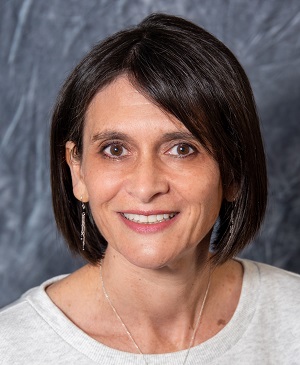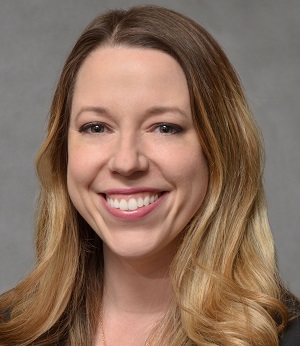Monthly deep brain stimulation class helps answer potential candidates’ questions and manage their expectations

When patients with movement disorders such as Parkinson’s disease, essential tremor or dystonia, get to the point where they’re considering deep brain stimulation (DBS) to help relieve their symptoms, the overall process can seem daunting. Two surgeries are required – one to implant the electrode in the brain and the other about a week later to implant the generator/battery under the skin beneath the collarbone. The patient must be awake for a portion of the first surgery, which can generate some anxiety. Even the multi-disciplinary DBS workup process can be intimidating.
Knowledge is power, right? In this case, knowledge about the DBS process is not only empowering, it can also reduce anxiety and generate informed questions to ask providers. “I know as a nurse, that when it comes to patient education, it’s good for everyone involved,” said Deep Brain Stimulation Program Manager Susan Vold, BSN, RN, PHN, HNB-BC, of the U of M’s Neurology Department.

Deep Brain Stimulation Program Manager Susan Vold helps lead the class
In 2014, Vold helped lead efforts that resulted in the creation of a monthly class for potential DBS patients and their advocates. Held on the U of M campus the third Wednesday of the month from 10 a.m. to noon, the class is taught by Vold, in partnership with Neurosurgery Department DBS Care Coordinator Karen Ellis, RN, BA; and Neurology Department Research Nurse Kelly Sovell, RN, MPH, AHN-BC.
When a patient expresses interest in the class, “Karen does her magic, coordinating everything,” said Vold. “She enrolls patients and puts a folder together for them that includes class handouts and PowerPoint slides.”
Purposefully kept small to encourage interaction, the three nurses walk participants through the required DBS work-up appointments, the actual surgery, the programming afterwards, and the research opportunities available. They discuss what DBS can and cannot do and describe realistic patient expectations. “We help them voice what symptoms they want improved. It’s not enough to say, ‘I want a better life,’ they need to be very specific about what will give them a better life.”
Perhaps a patient wants to be able to garden, write out their bills, or drink from a cup. “These are specific goals to deal with the motor aspects of Parkinson’s, which is what DBS treats,” explained Vold. “It may change someone’s life, but it won't make it perfect. Managing patients’ expectations about DBS and explaining their responsibility related to living well with their illness is key.”

Care Coordinator Karen Ellis oversees patient enrollment, helps answer their questions
In fact, if a potential patient cannot articulate clearly what they want improved with DBS, they may not be an appropriate candidate for the procedure. “They need to be able to verbalize what they are feeling and what symptoms they are having, especially during the programming process,” said Vold. “Saying that, ‘I feel funny,’ does not give us the information we need to optimize this therapy. For example, we need to know if the tremor returns on a specific hand.”
The nurses also discuss what’s required following the surgeries. “Patients often have questions about topics such as what they should expect in terms of post-operative recovery, healing, returning to work, resuming physical activity, and whether there are activities they should avoid after DBS,” said Ellis. “We discuss all of these issues…every question is important and we welcome them.”
Sovell brings a different perspective to the class. “I talk about research studies that are currently available,” she said. “The DBS class is a great way to introduce myself before patients are approved for the procedure. We talk about the idea of research before they have to make a decision.”
One of the studies Sovell helps manage is called the Clinical Core Study. “It’s a five-year study, much like a DBS registry, in which we follow participants closely,” she explained. “I become their Care Coordinator in the clinic, scheduling and attending all their appointments to get details about such things as device programming, medications, and health changes. We gather a lot of information.” The goal is to enroll 60 participants in the study.

Research Nurse Kelly Sovell introduces patients to studies available
Both Sovell and Vold are certified holistic nurses. Holistic nursing is generally defined as nursing practice that has healing the whole person as its goal. A licensed holistic nurse takes a mind-body-spirit-emotion-environment approach to the practice of traditional nursing. “We bring that perspective to the whole DBS program” said Vold. “We look not only at helping the patient with their physical symptoms, but also with their mental, emotional, spiritual and social needs.”
Many patients leave the class enthusiastic and ready for the next step. “They ask Karen, ‘OK, what do I need to do next…how do I get started,’” said Vold. Written evaluations tell the nurses that participants appreciate the informal nature of the class and the approachability and knowledge of its teachers. “They often tell their providers how much they enjoyed the class,” added Sovell. “It’s also a chance for people to meet others in the same situation so they know they’re not alone.”
Not content just to run the monthly class, the three nurses are putting the final touches on a handbook that supports the information they provide. “It goes through, in detail, what we talk about in the class,” said Vold. “It will be something we can give to patients in the clinic as well.”
If you would like to attend the class or have questions about it, please contact Karen Ellis at 612-626-6688.
Previous story about treating Parkinson's using DBS featuring neurosurgeon Michael C. Park, MD, PhD.



